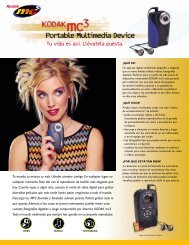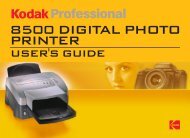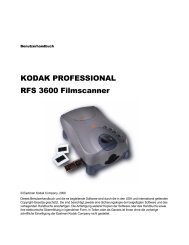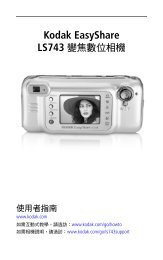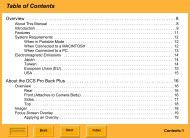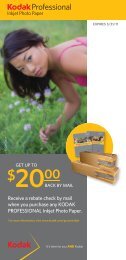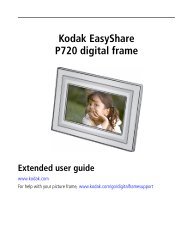KODAK EDGE Generations Paper
KODAK EDGE Generations Paper
KODAK EDGE Generations Paper
Create successful ePaper yourself
Turn your PDF publications into a flip-book with our unique Google optimized e-Paper software.
TECHNICAL DATA / COLOR PAPER<br />
<strong>KODAK</strong> <strong>EDGE</strong> <strong>Generations</strong> <strong>Paper</strong><br />
<strong>KODAK</strong> <strong>EDGE</strong> <strong>Generations</strong> <strong>Paper</strong> is an exceptional new<br />
color negative paper for making color prints from color<br />
negatives. Its advanced emulsion technology delivers<br />
enhanced color reproduction and superior image stability.<br />
Designed to work well in both optical and digital imaging<br />
systems, it is replacing <strong>KODAK</strong> EKTACOLOR <strong>EDGE</strong> 7<br />
<strong>Paper</strong>, <strong>KODAK</strong> EKTACOLOR <strong>EDGE</strong> 8 <strong>Paper</strong>, and <strong>KODAK</strong><br />
EKTACOLOR <strong>EDGE</strong> 9 <strong>Paper</strong>.<br />
This paper is available in a variety of sheet and roll sizes<br />
in E, F, and N surfaces. It is designed for processing in<br />
<strong>KODAK</strong> EKTACOLOR RA, <strong>KODAK</strong> EKTACOLOR<br />
PRIME, and <strong>KODAK</strong> EKTACOLOR PRIME LORR<br />
Chemicals for Process RA-4 or <strong>KODAK</strong> EKTACOLOR SM<br />
Chemicals for Process RA-2SM. Compared to<br />
EKTACOLOR <strong>EDGE</strong> 8 and <strong>EDGE</strong> 9 <strong>Paper</strong>, <strong>KODAK</strong><br />
<strong>EDGE</strong> <strong>Generations</strong> <strong>Paper</strong> features the following<br />
improvements:<br />
FEATURES BENEFITS<br />
• Improved digital printing Improved detail and cleaner<br />
text<br />
More robust calibration<br />
Improved flesh tone More natural skin tones<br />
reproduction<br />
Enhanced tone scale Improved flesh to neutral;<br />
warmer highlights<br />
©Eastman Kodak Company, 2002<br />
November 2003 • E-7010<br />
Compared to EKTACOLOR <strong>EDGE</strong> 7 <strong>Paper</strong>, this paper<br />
features the following improvements:<br />
FEATURES BENEFITS<br />
Increased color<br />
saturation<br />
Enhanced flesh-tone<br />
reproduction<br />
Richer, brighter, more<br />
compelling colors<br />
More vibrant greens, blues,<br />
and reds<br />
Exceptionally natural-looking<br />
skin tones<br />
New raw stock color Easier printer setup and focus<br />
State-of-the-art image<br />
stability<br />
Technology optimized for<br />
<strong>KODAK</strong> Films<br />
Improved process<br />
performance<br />
Improved light stability—Over<br />
100 years before noticeable<br />
fading in typical home display<br />
Significantly improved dark<br />
stability—Over 200 years<br />
before noticeable fading in the<br />
most common home storage<br />
conditions<br />
Bold, bright colors that last<br />
longer<br />
The best possible prints from<br />
<strong>KODAK</strong> MAX, GOLD,<br />
ROYAL GOLD and ADVANTIX<br />
Films<br />
Versatility to provide great<br />
results with other<br />
manufacturers' negative films<br />
Improved resistance to<br />
abrasion marks during<br />
processing<br />
Less waste<br />
Reduced process sensitivity to<br />
leuco cyan dye in the bleach-fix<br />
(
STORAGE AND HANDLING<br />
For optimum results, store unexposed paper at 13°C (55°F)<br />
or lower in the original package. You can store unexposed<br />
paper at 24°C (75°F) for up to 6 months and still achieve<br />
high-quality results. High temperatures or high humidity<br />
may produce unwanted changes.<br />
To avoid moisture condensation on paper that has been<br />
refrigerated, allow it to warm up to room temperature before<br />
opening the package. For best results, remove the package<br />
from cold storage the day before you use it, or allow the<br />
paper to warm up for the appropriate time listed in the<br />
following table.<br />
Handle paper carefully by the edges to avoid creases and<br />
fingerprints.<br />
Minimum Warm-Up Time (Hours) at<br />
Ambient Temperature of 21°C (70°F)<br />
Size From a Storage Temperature<br />
of<br />
Rolls: cm x m (in. x ft)<br />
8.9 x 93 (31⁄2 x 305)<br />
8.9 x 186 (31 ⁄2 x 610)<br />
8.9 x 253 (31⁄2 x 830)<br />
8.9 x 372 (31⁄2 x 1220)<br />
10.2 x 93 (4 x 305)<br />
10.2 x 186 (4 x 610)<br />
10.2 x 253 (4 x 830)<br />
10.2 x 372 (4 x 1220)<br />
12.7 x 93 (5 x 305)<br />
12.7 x 186 (5 x 610)<br />
12.7 x 253 (5 x 830)<br />
15.2 x 93 (6 x 305)<br />
15.2 x 186 (6 x 610)<br />
20.3 x 93 (8 x 305)<br />
20.3 x 186 (8 x 610)<br />
25.4 x 93 (10 x 305)<br />
25.4 x 186 (10 x 610)<br />
27.9 x 93 (11 x 305)<br />
30.5 x 93 (12 x 305)<br />
40.6 x 93 (16 x 305)<br />
50.8 x 93 (20 x305)<br />
Sheets<br />
20.3 x 25.4 cm (8 x 10 in.)<br />
(100-sheet box)<br />
27.9 x 35.6 cm (11 x 14 in.)<br />
40.6 x 50.8 cm (16 x 20 in.)<br />
(50-sheet box)<br />
-18°C<br />
(0°F)<br />
5<br />
7.5<br />
8<br />
10<br />
5<br />
8<br />
9<br />
10.5<br />
5.5<br />
9<br />
11<br />
5.5<br />
9.5<br />
2°C<br />
(35°F)<br />
3.5<br />
5.5<br />
6<br />
8<br />
13°C<br />
(55°F)<br />
Warm-up times for pallets of paper will vary. For<br />
example, one pallet of 44 8.9 cm x 372 m (3 1 ⁄2 in. x 1220-ft)<br />
rolls (4 stacks of 11 rolls) stored at 2°C (35°F) would require<br />
a minimum warm-up time of 24 hours at 21°C (70°F).<br />
4<br />
6<br />
7<br />
8<br />
4<br />
7<br />
8.5<br />
4.5<br />
7.5<br />
2.5<br />
4<br />
4<br />
6<br />
2.5<br />
4.4<br />
5<br />
5.5<br />
2.5<br />
5<br />
7<br />
3<br />
5<br />
11 8 5.5<br />
6<br />
11.5<br />
4.5<br />
8.5<br />
3<br />
6<br />
6 4.5 3<br />
3 2 1.5<br />
1.5 1 1<br />
DARKROOM RECOMMENDATIONS<br />
Handle this paper in total darkness. Be sure that your<br />
darkroom is lighttight. Eliminate any stray light from timers,<br />
LEDs, etc. <strong>EDGE</strong> <strong>Generations</strong> <strong>Paper</strong> is sufficiently sensitive<br />
to photographic process lighting (safelights) that<br />
sensitometric shifts may occur before D-min (fog) changes<br />
are seen.<br />
Note: Using a safelight will affect your results. If absolutely<br />
necessary, you can use a safelight equipped with a <strong>KODAK</strong><br />
13 Safelight Filter (amber) with a 71⁄2-watt bulb. Keep the<br />
safelight at least 4 feet (1.2 metres) from the paper. Keep<br />
safelight exposure as short as possible. Run tests to<br />
determine whether safelight use gives acceptable results for<br />
your application. For information on safelight testing, see<br />
<strong>KODAK</strong> Publication No. K- 4, How Safe is Your Safelight?<br />
EXPOSURE<br />
You can expose this paper in automatic printers, such as<br />
<strong>KODAK</strong> CLAS 35 II and <strong>KODAK</strong> CLAS III Color Printers,<br />
<strong>KODAK</strong> CREATE-A-PRINT 35 mm Enlargement Centers,<br />
<strong>KODAK</strong> Minilab Systems, <strong>KODAK</strong> 3510 Color Printers,<br />
<strong>KODAK</strong> 312 Color Printers, <strong>KODAK</strong> I.LAB Digital<br />
High-Speed Printers, AGFA High-Speed Printers, GRETAG<br />
High-Speed Printers, GRETAG Minilabs and Microlabs,<br />
NORITSU Minilabs and Microlabs, FUJI FRONTIER and<br />
other FUJI Minilabs, KONICA Minilabs, PHOTO-ME<br />
Minilabs, and more.<br />
Note: Printer and balance slope changes may be necessary.<br />
Check production after final balance. You may want to make<br />
a color preference adjustment.<br />
If you are using Agfa MSP or MSC printers, visit<br />
http://www.kodak.com/go/colorpapers or contact your<br />
Kodak representative to obtain Schwarzschild coefficients.<br />
Agfa's current recommendation is that the Schwarzchild<br />
coefficients are the same for <strong>KODAK</strong> <strong>EDGE</strong> <strong>Generations</strong><br />
<strong>Paper</strong> as for <strong>KODAK</strong> EKTACOLOR <strong>EDGE</strong> 8 and <strong>EDGE</strong> 9<br />
<strong>Paper</strong>s.<br />
Because voltage changes affect the light output and color<br />
quality, use a voltage regulator. Use a tungsten-halogen lamp<br />
to expose the paper. Do not use a fluorescent lamp. If the<br />
printer has no means of removing infrared radiation, use a<br />
heat-absorbing glass.<br />
Keep negatives and the optical system of your equipment<br />
clean. Mask negatives to eliminate stray light.<br />
To control the color balance, use dichroic filters, <strong>KODAK</strong><br />
Color Printing Filters (CP), or <strong>KODAK</strong> Color Compensating<br />
Filters (CC) placed between the lamp and the negative. You<br />
can also use CC filters between the lens and the paper if they<br />
are clean and unscratched. Use as few CC filters between the<br />
lens and the paper as possible—preferably not more than<br />
three. If you use cyan filtration, use filters with the suffix<br />
“-2,” such as CP10C-2.<br />
Start with a filter pack of 40M + 40Y for the white-light<br />
method. Adjust filtration as necessary.<br />
2 <strong>KODAK</strong> <strong>EDGE</strong> <strong>Generations</strong> <strong>Paper</strong> • E-7010
Printer Control Negative Sets<br />
Use the appropriate <strong>KODAK</strong> Printer Balancing Kit to<br />
determine aims for <strong>KODAK</strong> Color Negative Films or to<br />
cross over from another type of color paper to <strong>KODAK</strong><br />
<strong>EDGE</strong> <strong>Generations</strong> <strong>Paper</strong>.<br />
LATENT-IMAGE KEEPING<br />
For best results, process the paper on the same day that you<br />
expose it. (If latent-image shifts occur, minimize them by<br />
keeping the time between exposure and processing as<br />
consistent as possible.)<br />
PROCESSING<br />
Use <strong>KODAK</strong> EKTACOLOR Chemicals for Process RA-4 or<br />
<strong>KODAK</strong> EKTACOLOR SM Chemicals for Process<br />
RA-2SM. For FUJI FRONTIER Processors, use <strong>KODAK</strong><br />
EKTACOLOR Processing Cartridge 111 and <strong>KODAK</strong><br />
EKTACOLOR PC111 Rinse Tablets. Use <strong>KODAK</strong> Control<br />
Strips, Process RA-4 to monitor your process.<br />
For more information on processing chemicals, see<br />
www.kodak.com/go/photochemicals.<br />
Use a maximum drying temperature of 96°C (205°F).<br />
VIEWING<br />
Evaluate prints under light of the same color and brightness<br />
that you will use to view the final prints. For an average<br />
condition, use a light source with a color temperature of<br />
5000 ± 1000 K, a Color Rendering Index (CRI) of 85 to 100<br />
(an index of 90 or higher is desirable), and an illuminance up<br />
to 500 lux. Fluorescent lamps such as a cool white deluxe<br />
lamp (made by several manufacturers) meet these conditions<br />
You can also use a mixture of fluorescent and incandescent<br />
lamps. For each pair of 40-watt cool white deluxe lamps, use<br />
a 75-watt frosted tungsten bulb.<br />
PRINT FINISHING<br />
Dust Spotting<br />
Use <strong>KODAK</strong> Liquid Retouching Colors to correct dust spots<br />
on prints made with this paper. To apply dyes, follow this<br />
procedure:<br />
1. If necessary, clean the surface of the print by buffing it<br />
with a tuft of cotton before you start retouching. Be<br />
careful not to scratch the surface. Protect the print from<br />
fingerprints and perspiration by wearing cotton gloves<br />
(e.g., <strong>KODAK</strong> Cotton Gloves).<br />
2. Transfer a small amount of the dye(s) you need to a<br />
palette.<br />
3. If necessary, add a touch of neutral dye to the puddle of<br />
pure colored dye. The neutral dye will reduce the<br />
brilliance of the pure colors by adding density. For<br />
good control, keep the dilutions weak by adding a little<br />
distilled water. This allows you to build up the dye<br />
gradually on the print. It is easier to add dye gradually<br />
than to remove it if you apply too much.<br />
Note: If the liquid dyes on your palette dry out, you can add<br />
water to dilute them again.<br />
4. Pick up a small amount of dye with your brush, and<br />
stroke the brush on newsprint or a paper towel to blot it<br />
thoroughly. Too much moisture can cause opalescence,<br />
or a cloudy look, on the print. Rotate the tip on the<br />
newsprint to form a good point. Do not use your tongue<br />
or lips to form a tip.<br />
5. Retouch the print with light strokes of the brush; be<br />
sure to keep the dye within the area of the spot. Avoid<br />
spilling over into the surrounding area. Any<br />
overlapping will result in a dark ring around the spotted<br />
area.<br />
6. If you apply too much color, blot it quickly with<br />
newsprint or you will have too much density in the<br />
spot. If too much dye penetrates the emulsion, you can<br />
remove it with a 5-percent clear ammonia-water<br />
solution. (You can make a 5-percent solution by mixing<br />
5 parts of 28-percent liquid ammonium hydroxide with<br />
23 parts water.) Apply the solution with a tuft of cotton,<br />
rubbing it with a circular motion. Be sure to apply it<br />
only to the area where you want to remove the dye.<br />
Then swab the area with clean water-dampened cotton.<br />
Repeat if necessary with a fresh tuft of cotton. Be sure<br />
to remove all of the ammonia. Allow the area to dry<br />
thoroughly before you resume retouching. For best<br />
results, remove unwanted dye quickly.<br />
STORAGE AND DISPLAY OF PRINTS<br />
<strong>KODAK</strong> <strong>EDGE</strong> <strong>Generations</strong> <strong>Paper</strong> has been formulated to<br />
provide improved dye stability and print longevity for prints<br />
displayed under typical home lighting conditions (i.e., 120<br />
lux for 12 hours a day), and typical home dark storage<br />
conditions (i.e., 20 to 23°C [68 to 73.4°F] and 50% relative<br />
humidity). Product modifications have provided an<br />
improvement in the fade neutrality when compared with<br />
previous papers.<br />
Despite the improvements in print longevity and fade<br />
neutrality, photographic dyes, like all dyes, can change with<br />
time and exposure to sunlight, ultraviolet radiation,<br />
excessive heat, and high humidity. To help prevent changes<br />
in photographic dyes, follow these guidelines:<br />
Illuminate prints with tung sten light whenever possible.<br />
Display prints in the lowest light level consistent with<br />
your viewing needs.<br />
If a print is exposed to direct or indirect sunlight or<br />
fluorescent light, use an ultraviolet-absorbing filter<br />
(such as glass) between the light source and the print.<br />
Keep the temperature and hum idity as low as possible.<br />
For prints displayed behind glass, maintain a slight<br />
separation between the prints and the glass.<br />
Use album materials described in <strong>KODAK</strong> Publication<br />
No. E-30, Storage and Care of <strong>KODAK</strong> Photographic<br />
Materials—Before and After Processing.<br />
<strong>KODAK</strong> <strong>EDGE</strong> <strong>Generations</strong> <strong>Paper</strong> • E-7010 3
Mounting/Laminating<br />
Prints can be mounted using a contact type adhesive or<br />
cement for cold mounting. In addition, prints can be<br />
mounted or laminated using pressure sensitive materials<br />
with a roller mounting or laminating system.<br />
If the prints are to be displayed behind glass, maintain a<br />
slight separation between the print and the glass.<br />
Mounting or laminating prints at high temperatures is not<br />
recommended.<br />
SIZES AVAILABLE<br />
Roll Width Roll Length<br />
93 m<br />
(305 ft)<br />
186 m<br />
(610 ft)<br />
253 m<br />
(830 ft)<br />
333 m<br />
(1092 ft)<br />
372 m<br />
(1220 ft)<br />
575 m<br />
(1886 ft)<br />
8.2 cm (3.25 in.) ✔ ✔<br />
8.9 cm (3.5 in.) ✔ ✔ ✔ ✔ ✔ ✔<br />
10.2 cm (4 in.) ✔ ✔ ✔ ✔ ✔ ✔<br />
11.7 cm (4.6 in.) ✔<br />
12.1 cm (4.75 in.) ✔<br />
12.7 cm (5 in.) ✔ ✔ ✔ ✔<br />
15.2 cm (6 in.) ✔ ✔<br />
20.3 cm (8 in.) ✔ ✔<br />
25.4 cm (10 in.) ✔ ✔<br />
27.9 cm (11 in.) ✔<br />
30.5 cm (12 in.) ✔<br />
40.6 cm (16 in.) ✔<br />
50.8 cm (20 in.) ✔<br />
Sheets: 20.3 x 25.4 cm (8 x 10-in.), 27.9 x 35.6 cm (11 x 14-in.), 40.6 x 50.8 cm (16 x<br />
20-in.), 50.8 x 76.2 cm (20 x 30-in.)<br />
4 <strong>KODAK</strong> <strong>EDGE</strong> <strong>Generations</strong> <strong>Paper</strong> • E-7010
CURVES<br />
Density<br />
4.0<br />
3.0<br />
2.0<br />
1.0<br />
Characteristic Curves<br />
Process RA-4; 100 F (38 C), 45 sec<br />
Densitometry: Status A<br />
0.0<br />
-4.00 -3.00 -2.00 -1.00 0.00 1.00<br />
Log Exposure (lux seconds) F002_1214AC<br />
R<br />
LOG SENSITIVITY*<br />
2.0<br />
1.0<br />
0.0<br />
1.0<br />
2.0<br />
250<br />
G<br />
B<br />
300<br />
Spectral Dye Density Curves<br />
Process RA-4; D=1.0<br />
0<br />
400 450 500 550 600 650 700<br />
Wavelength (nm)<br />
F002_1215AC<br />
<strong>KODAK</strong> <strong>EDGE</strong> <strong>Generations</strong> <strong>Paper</strong> • E-7010 5<br />
Diffuse Spectral Density<br />
1.4<br />
1.2<br />
1.0<br />
0.8<br />
0.6<br />
0.4<br />
0.2<br />
Spectral Sensitivity Curves<br />
Process: RA-4<br />
350<br />
Yellow-<br />
Forming<br />
Layer<br />
Magenta-<br />
Forming<br />
Layer<br />
400 450 500 550 600<br />
WAVELENGTH (nm)<br />
Yellow<br />
700 750<br />
Magenta<br />
NOTICE: The sensitometric curves and data in this publication represent product tested<br />
under the conditions of exposure and processing specified. They are representative of<br />
production coatings, and therefore do not apply directly to a particular box or roll of<br />
photographic material. They do not represent standards or specifications that must be met<br />
by Eastman Kodak Company. The company reserves the right to change and improve<br />
product characteristics at any time.<br />
650<br />
*Sensitivity = reciprocal of exposure (ergs/cm ) required<br />
to produce specified density<br />
F002_1049AC<br />
2<br />
Cyan-<br />
Forming<br />
Layer<br />
Cyan
<strong>KODAK</strong> <strong>EDGE</strong> <strong>Generations</strong> <strong>Paper</strong><br />
MORE INFORMATION<br />
Kodak has many publications to assist you with information<br />
on <strong>KODAK</strong> products, equipment, and materials.<br />
Additional information on <strong>KODAK</strong> <strong>EDGE</strong> <strong>Generations</strong><br />
<strong>Paper</strong> is available on the Kodak website at:<br />
http://www.kodak.com/go/colorpapers. Additional<br />
information on <strong>KODAK</strong> Chemicals and paper processing is<br />
available at http://www.kodak.com/go/photochemicals.<br />
The following publications are available from dealers who<br />
sell <strong>KODAK</strong> products, or you can contact Kodak in your<br />
country for more information.<br />
E-30 Storage and Care of <strong>KODAK</strong> Photographic<br />
Materials—Before and After Processing<br />
<strong>KODAK</strong> <strong>EDGE</strong> <strong>Generations</strong> <strong>Paper</strong><br />
<strong>KODAK</strong> Publication No. E-7010<br />
CAT 846 0115<br />
For the latest version of technical support publications for<br />
<strong>KODAK</strong> Products, visit Kodak online at:<br />
http://www.kodak.com<br />
If you have questions about <strong>KODAK</strong> Products, call Kodak.<br />
In the U.S.A.:<br />
1-800-242-2424, Monday–Friday<br />
9 a.m.–7 p.m. (Eastern time)<br />
In Canada:<br />
1-800-465-6325, Monday–Friday<br />
8 a.m.–5 p.m. (Eastern time)<br />
Note: The <strong>KODAK</strong> materials described in this publication<br />
for use with <strong>KODAK</strong> EKTACOLOR <strong>EDGE</strong> <strong>Generations</strong><br />
<strong>Paper</strong> are available from dealers who supply <strong>KODAK</strong><br />
Products to photofinishers. You can use other materials, but<br />
you may not obtain similar results.<br />
Consumer Imaging<br />
EASTMAN <strong>KODAK</strong> COMPANY • ROCHESTER, NY 14650<br />
Kodak, Advantix, Create-A-Print, Edge, Ektacolor, Gold, I.Lab, Max, Royal, Prime, and<br />
Gold are trademarks of Eastman Kodak Company.<br />
Revised 11-03<br />
Printed in U.S.A.



